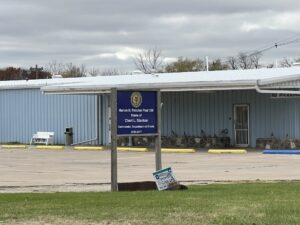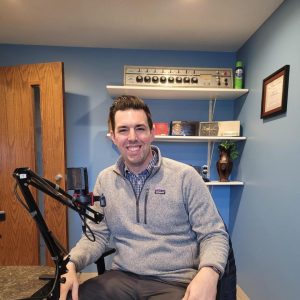In July, one of the biggest stories in science was a 46,000-year-old worm that was brought back to life after being found in a layer of Siberian permafrost.
The worm, a previously unknown species of nematode, survived after entering a dormant state known as cryptobiosis, during which the animal doesn’t eat and lacks a metabolism. The finding was detailed in a recent study published in the journal PLOS Genetics.
On the Monmouth College campus, the faculty member most qualified to discuss worms is biology professor Janet Ugolino, whose specialty is neuroscience. She and her students use the microscopic nematode species C. elegans in their study of neurodegenerative diseases such as Alzheimer’s and Parkinson’s.
“I wasn’t too surprised by the news, because they’ve been found in the Arctic and Antarctic and in deep caves,” said Ugolino. “The age was the cool thing about it. It’s the oldest one found to date.”
Although the original worm has since died, said Ugolino, “It laid eggs, and there are progeny still in the lab.”
The nematode wasn’t C. elegans, which is the species Ugolino and three students are currently researching during the College’s three-week Summer Opportunities for Intellectual Activities program – also known as SOFIA – which concludes with poster presentations Aug. 19, also the date of 2023-24 matriculation ceremony. Their project is titled “Worm Hunting: Investigating Nematode Diversity at Monmouth College.”
“There’s a lot going on today in the nematode world,” said Ilese Rodeffer ’25 of Bushnell, Illinois, during the group’s presentation at the end of SOFIA’s first week.
“Only certain (microscopic) organisms are able to do this,” said Ugolino of cryptobiosis. “Another example of a species that’s able to do this is tardigrades, which are also known as ‘water bears’ since they look like a teddy bear. They have been known to survive extreme conditions” and, according to a National Geographic article, “would likely survive the apocalypse.”
“NASA has used them in some of their space experiments,” said Ugolino.
The space agency said that revealing what makes tardigrades so tolerant “could lead to ways of protecting biological material, such as food and medicine, from extreme temperatures, drying out and radiation exposure.”
Why study C. elegans?
While that is certainly one reason to study specific microorganisms, Ugolino and her neuroscience students are interested in the nematode C. elegans for the more down-to-earth reason of learning more about neurodegenerative diseases.
“They are a model organism for research, especially for human disease,” said Elizabeth Towery ’26 of Havana, Illinois, one of two new students working on the SOFIA research, along with Parker Burch ’27 of Calhan, Colorado. “They are relatively easy to work with, they have an established life cycle – from egg to mature adult in three days – and they are transparent, with simple nervous and digestive systems.”
“You can ask a simple question and get a simple answer,” said Ugolino. “They also produce a lot of offspring in a limited amount of time – a much shorter time frame than humans, for example. They have a short growth cycle of about three days, and they’re easy to maintain and to handle.”
Also, said Rodeffer, “The genome for C. elegans is fully sequenced, and many human genes have orthologs in C. elegans, which allow us to study human processes.”
“The genome is also easily manipulated,” said Ugolino, “so it’s easy to see the consequence if a certain gene is removed. In certain experiments, C. elegans might slow down, or even become paralyzed. It’s harder to manipulate the genome of similar nematodes.”
Hunting for nematodes
Rodeffer reported that “four out of five animals on earth are nematodes.”
“That statistic is cited a lot,” said Ugolino. “Nematodes are definitely the most abundant group in the animal world. Another statistic says there are between 30,000 and 40,000 species of nematodes, and the total may be as high as one million, with so many species that haven’t been discovered yet.”
A next step in research involving C. elegans is to find diverse species of the nematode. To that end, the SOFIA students hunted for nematodes in a pair of nearby settings – the College’s garden by Founders Village and the garden of faculty member Jen Braun.
Their best sample – soil found beneath a rotted apple – produced 17 nematodes.
“We don’t think we have any C. elegans, but we have several different species,” said Burch.
The students are identifying the species they’ve found through a variety of lab techniques, including microscopy, PCR (polymerase chain reactions) and DNA sequencing.
“It has been shown that C. elegans isolated from the wild exhibit different behaviors than the standard strain that we use in the lab,” said Ugolino. “It would be great to find more C. elegans wild isolates so we could further study these behavioral differences.”
Who knows? Perhaps such a species of C. elegans is just chilling out in some permafrost, waiting to be discovered and revived.
***Courtesy of Barry McNamara, Monmouth College***














